Now you're really starting to learn useful stuff. Getting "the feel" for what a fixing feels like just before it shears and also how tight is "proper tight" is absolutely invaluable. You'll still break things, we all do, but you'll break a lot less of them!
Stud extractors? useful but you really need to be careful with them because they are made from very very "hard" metal. If you snap one off in the hole then life gets a whole lot more complicated because to all intents and purposes the amateur driveway grease monkey can't do much about removing the broken bit
They come in two types - as far as I know? reverse helix or square. Come to think of it I've never seen one for a left hand thread? Suppose they must exist? Anyway, here's my little "pick and mix" selection:
View attachment 449562
taking a closer look at the two types:
View attachment 449563
The top one is, obviously, of the square type. Look closely and you can see it has a groove down one side? to use it you drill a suitable size hole down the centre of the broken bolt/stud and insert the tool small end first. Then give it a few sharp taps with a hammer so the flutes bite into the sides of the hole and gently turn the square top anticlockwise with a tap wrench, spanner, or other suitable tool.
The lower one is a reverse helix type. The preparation is similar in that you drill a suitable size hole - both my sets of these eezi outs, as they are commonly called, have a suggested drill size stamped on their shanks - and then insert the "pointy end" of the tool into the hole. However, with the reverse helix type you only need to tap them quite lightly as they well wind themselves in with their helical faces as you start to turn them. Unfortunately this can cause a problem with this type because the tighter the broken stud is the further the tool will wind itself into the hole and, because it's a tapered tool, the further it winds itself into the hole the more it will force the stud to expand and lock itself even tighter into the hole! For this reason I prefer the American square shank type.
If the broken stud is very tight in it's hole it's quite possible to snap the tool off in the hole and that's not funny. I tend to pay a lot of attention to how it feels as I'm applying force to it. I don't tend to apply just one increasing effort but rather I "nudge" it a little at a time, increasing the force each time until the tool starts to feel "springy" - like as if it's a torsion bar. I do risk a bit of "springyness action" but if it doesn't shift I go no further because past experience has proved to me it's probably going to snap off. and this happens with both types of tool.
I find them of limited use. Yes there is the odd occasion when circumstances conspire to let them work really well but I don't use them often and, for me, they are a bit of a luxury. By the way, if you're going to buy a set then please don't buy a "cheap" set. The cheaper ones are often made from high carbon steel, very hard so bites into the stud well but VERY brittle so really easy to snap. Better sets are made from tool steel which will withstand more abuse before snapping but cost quite a lot more.





